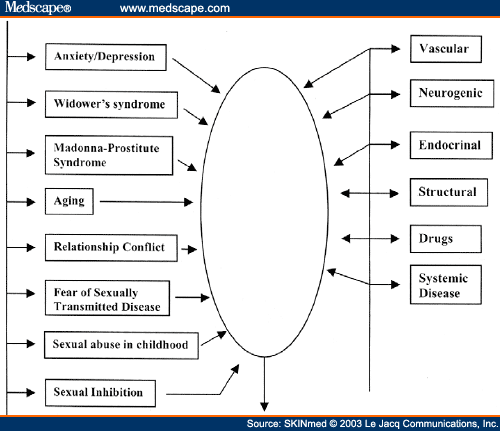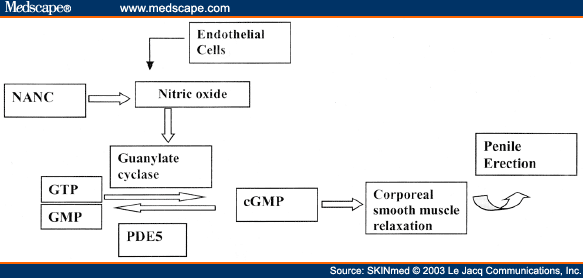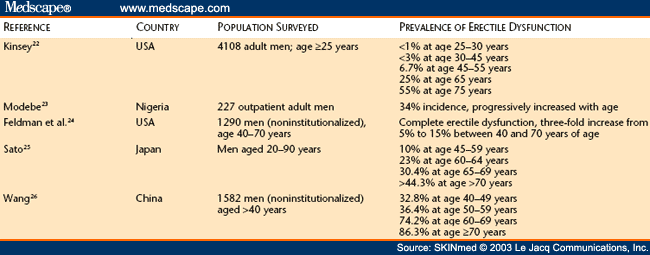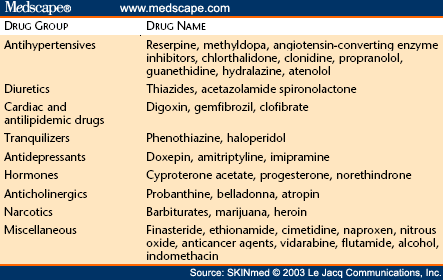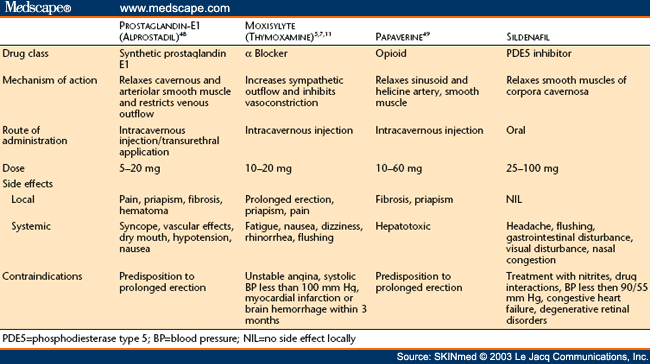
|
|
|||
| Virendra N. Sehgal, MD; Govind Srivastava, MD, SKINmed 2(6):350-356, 2003 Posted 1 May 2004 Abstract Erectile dysfunction is one of the prime challenges confronting the treating physician. Its prevalence is directly proportional to aging. It is imperative to comprehend the intricate mechanism of erection in order to individualize the approach to management. Thus, it is appropriate to evaluate the etiology of erectile dysfunction. Normal aging, as well as psychogenic, vascular, neurogenic, and endocrinologic causes and/or those due to structural abnormalities of the penis should be considered when evaluating details to determine its probable cause. An increasing use of drugs, a legacy of civilization, has considerably compounded the problem. Therapy for erectile dysfunction, apart from psychosexual counseling, includes medical treatment by alpha adrenoceptor antagonists, dopamine agonists, phosphodiesterase type 5 inhibitors, sublingual apomorphine hydrochloride, or hormone therapy. Transdermal or transurethral corporeal drug delivery are other possible treatment modalities. Vacuum devices and surgical approaches are considered relevant only in refractory cases. Introduction A satisfactory sexual life is the prime factor of a harmonious marriage. Unfortunately, this harmony may be jeopardized by the occurrence of erectile disorders, and often lead to separation. These disorders are commonly encountered in medical practice among men.[1 & 5] Increasing awareness about sex and liberal social norms motivate people to seek medical consultation for the problem commonly recognized as impotence; yet, impotence may not always signify an erectile dysfunction.[3 & 6] Several causes may be responsible for erectile dysfunction in different age groups. Occasionally, psychogenic and organic impotence may arise in an individual patient.[2,4 & 8] The recent introduction of sildenafil in the management of these disorders (Figure 1), and the associated controversies and side effects, has rekindled an intriguing dialogue. The treatment, therefore, may vary from individual to individual.[6,9] This review will attempt to focus attention on the salient emerging scenario of these disorders and to delineate an equitable approach to pertinent therapy.[2, 4, 6 & 10] Figure 1. Spectrum of erectile dysfunction
Definition The term erectile dysfunction was coined in 1974.[11] It has been defined as the persistent inability for 3 months or more to attain and/or maintain sufficient erection, a prerequisite necessary for satisfactory sexual intercourse.[11 & 15] Erectile dysfunction is believed to be a more precise and communicative term, in contrast to impotence, the term used previously. Impotence signifies a lack of strength or sexual destitution, while erectile dysfunction means disorders arising out of total failure/partial erection. The definition of erectile dysfunction distinguishes itself from other disorders, e.g., inability to achieve orgasm, low libido, premature ejaculation; however, the latter condition(s) may form a component of erectile disorders.[11,14,15] Prevalence The prevalence of erectile dysfunction may increase with advancing age [7,15] and the degree may fluctuate, ranging from a partial decrease in penile rigidity to complete failure of erection.[14,16,17] Its prevalence varies from 30%–40% at age 40, to up to 70% at 70 years and older.[7,9,17,18] Younger patients have a lower rate of occurrence of complete erectile failure, while with advancing age the degree of erectile dysfunction gets more severe.[9,16] The prevalence and incidence of erectile dysfunction appears to be uniform throughout the globe, irrespective of racial or ethnic variations.[15] Nonetheless, in countries with sexual taboos and in other developing countries, the entity is usually infrequently and under-reported.[9,10,13,16] Epidemiologists encounter frequent patient resistance and unwillingness to discuss erectile dysfunction. People fail to report their problem due either to embarrassment or by presuming it to be a normal aging process not amenable to medical treatment.[19–21] A few well-documented studies [22–26] depicting the trend of erectile dysfunctions in various parts of the world are shown in Table I. Mechanism of Erection A spontaneous and simple-appearing sexual act, in fact, is a series of meticulously synchronized processes. Its precise erudition may add to the comprehension of the physiological phenomenon, comprising libido, erection, copulation, orgasm, and the ejaculation. The proper functioning of the sexual apparatus is dependent not only on its nervous and muscular integrity, but also on the endocrinal and psychic factors. Other systems of the body are complementary and their disorders may ultimately affect this phenomenon, causing erectile dysfunctions. Thus, erection is a complex, involuntary, neuropsychological, hormone mediated vascular event that happens when blood flows rapidly into the penis and becomes trapped in its spongy chamber. Libido The cerebral cortex is the chief controlling focus of the sex apparatus. Libido is the conscious feeling of the sexual urge, which originates in the brain center through the impulses received by various sense organs. In the event of aroused libido, the brain center sends impulses to the spinal center, which in turn passes them expeditiously to the peripheral nerves of the penis. Erection The preceding activities of the nerve endings cause dilatation of arterioles by relaxing their smooth muscle coat, which in turn causes filling of the spaces of corpora cavernosa resulting in its expansion. Accordingly, strong pressure is exerted on the veins that normally drain blood from the penis. The pressure is adequate to close the veins thus trapping the blood in the penis. The result is the thickening, rigidity, and elongation of the penis. An erector muscle of the penis (ischiocavernosus) draws the penis forward and makes it well adapted for penetration of the vagina. Copulation After the penis is inserted in the vagina, an act of sexual intercourse or copulation takes place, and continues until the time of orgasm and subsequent ejaculation. Orgasm and Ejaculation Friction between the glans penis and vaginal mucosa, reinforced by several other afferent stimuli and psychogenic factors, causes a reflex discharge along the sympathetic to the seminal pathway, the muscle coats of the epididymis, ductus deferens, the seminal vesicles, and the prostate gland. The sperm, along with the secretion of the accessory glands, are discharged into the posterior urethra, between the internal and external sphincter of the bladder. After orgasm is reached, the rhythmic contractions of the bulbocavernous and ischiocavernous muscles ejaculate the semen through the penis into the vagina. Sympathetic nerves, which act as a motor to the seminal tract, simultaneously close the internal vesicle sphincter, and thus prevent a reflex of semen into the bladder. Further, the contraction of detrusor vesicae and the associated inhibition of constrictor vesicae prevent a simultaneous discharge of urine. Detumescence After ejaculation and cessation of exotic stimuli, sympathetic tonic discharge resumes; this results in the contraction of smooth muscles around sinusoidal spaces and arterioles. Arterial flow is diminished to flaccid levels, much of the blood from sinusoidal spaces is expelled, and the venous channels are restored (Figure 2). Figure 2. Sequence of penile erection following sildenafil citrate NANC = nonadrenergic, noncholinergic nerve ending; GTP = guanosine triphosphate; cGMP = cyclic guanosine monophosphate; PDE5 = phosphodiesterase type 5
Types of Erectile Dysfunction Erectile dysfunctions are perceived in the form of a spectrum: at one end there is psychogenic erectile dysfunction, while at the other end there is organic/physical erectile dysfunction. They are abridged by mixed erectile dysfunction, which is composed of a variable mixture of psychogenic and organic factors (Figure 1). With advanced techniques of diagnosis of the erectile functions it has been found that more than 75% of patients have organic causes. This finding contrasts with the previous theories propagating the view that more than three quarters of erectile dysfunctions are of psychogenic origin.[27–29] Etiology and/or Risk Factors Primary erectile dysfunction is rather unusual, and denotes that the man has never been able to achieve/sustain an erection. This is usually due to physical causes such as endocrinopathies, nervous system disorders, or maldevelopment of the penis and its incompetent veins. Secondary erectile dysfunction is usually encountered in clinical practice and can have varied etiology and/or risk factors. Often a combination of several predisposing causes may be operating. Aging Aging has the strongest association with erectile dysfunction, and may be a common denominator in many patients. With aging, there may occur atheroma of internal iliac arteries and their pudendal branches. Further, there is degeneration of the extra-corporeal smooth muscles resulting in venous leakage in the penis. The prevalence of impotence increases with advancing age.[24] Psychogenic Causes Psychogenic causes include, among others, states of anxiety, depression, a troubled relationship, and fear of performance. Psychogenic erectile dysfunction usually has an acute onset, often related to specific events. The patient may have a normal nocturnal or masturbatory erection. Psychogenic impotence involves direct inhibition from the brain to the special centers. The psychogenic stimuli to the sacral cord may inhibit reflexogenic erection and subsequently activation of the parasympathetic dilator nerves to the penis. Later, the cavernous smooth muscles become less sensitive to the neurotransmitters because of the excessive sympathetic outflow and elevated catecholamine levels. Performance anxiety, relationship conflicts, and other fears also affect the process of erection.[19,22,25,30] Initially, psychogenic impotence was regarded as the major cause of erectile dysfunction (over 90%), but recent studies[30,31] incorporating detailed history and examinations revealed other organic causes in more than 50%–70% of occurrences. Another 10%–20% of patients have a mixture of psychogenic and organic causes.[32] Vascular Causes Arterial causes or a venous leak in the penis may also lead to erectile dysfunction. The former include atherosclerosis due to smoking, diabetes, low levels of high-density lipoprotein cholesterol, high levels of low-density lipoprotein, and total cholesterol, as well as hypertension. Erectile dysfunction may also occur after vascular surgery. Treated heart disease is associated with 78% impotence in nonsmokers and 94.3% impotence in smokers.[24] Diabetic men have an erectile dysfunction prevalence ranging from 35%–75%, due mainly to damage of small blood vessels.[16,17,30] Diabetic peripheral autonomic neuropathy is yet another contributory factor. The age factor may further accentuate damage.[31–33] Neurogenic Causes Diabetes[16,17] and alcoholic neuropathy,[20,21] spinal cord injury, nerve damage, multiple sclerosis, and cerebrovascular accidents are significant contributory factors for organic impotence. Damage or degeneration of peripheral nerves supplying the corpora may also cause impotence; cauda equina, and the lesions due to prolapsed intervertebral disc and iatrogenic neural injury during abdominoperineal resection of the rectum[20,21,24,28] are some examples. Endocrinologic Causes Endocrinologic causes include hypogonadism, pituitary tumor and hypo- and hyperthyroidism. Further, testosterone secreted from Leydig's cell of the testes under the influence of luteinizing hormone affects men's sexuality.[16,17] Thus, the medications such as luteinizing hormone, releasing hormone agonist or stilbestrol, which lower circulating testosterone also cause erectile dysfunction. Adrenal androgens, metabolite dehydroepiandrosterone sulfate, show a strong correlation with impotence. The age-adjusted possibility of complete impotence increased from 3.4% to 16% as the levels of dehydroepiandrosterone sulfate decreased from 10mg/mL to 0.5 mg/mL.[24] Structural Abnormalities of the Penis Peyronie's disease, priapism, and trauma are examples of structural penile abnormalities. In Peyronie's disease, there is fibrosis and scarring in the corpora albuginea. Further loss of tunica elasticity may cause venous leakage and induce impotence. In priapism there is an involuntary erection lasting for 4–6 hours. Spontaneous priapism may be idiopathic or associated with sickle-cell anemia, leukemia, or other malignancies; subsequently, the patient develops corporeal fibrosis resulting in erectile failure.[4,7,10] Drug-Induced Erectile Dysfunction Erectile dysfunction has also been reported in patients on psychotherapeutic drugs, which produce central nervous system depression. It is variously considered to be due to an elevation of serum prolactin concentration, sedative effect, anticholinergic effect, decreased dopamine activity, or central effects on the limbic system.[4,7,10] More and more drugs are being added to the list of those which induce erectile dysfunction (Table II). Chronic Renal Failure Men with chronic renal failure frequently complain about impaired erectile function; its prevalence can be as high as 45%.[33] Although the exact pathogenesis of impotence in chronic renal failure is not yet clear, multiple hypotheses have been debated. Hypogonadism due to dysfunction of Leydig's cells, hyperprolactinemia, hyperparathyroidism, anemia, protein malnutrition, zinc deficiency, hypertension, and use of antihypertensive drugs[33] are a few implicated propositions. Evaluation of Erectile Dysfunction Various tests and observations tend to precisely delineate causes in an individual. Nocturnal Studies Sleep laboratories monitor patients for rapid eye movement (REM) sleep, when an erection is seen. This rules out any organic cause.[17,34] Pharmacologic Studies Some physicians advocate intracavernosal injection of a small amount (10 mg of prostaglandin E1) of alprostadil. It induces normal/priapic erection in psychogenic impotence.[27,34] Vascular Erectile Testing A test of questionable value, duplex Doppler ultrasonography, has been used to evaluate arterial and venous blood flow of the penis. Dynamic infusion pharmaco-cavernosometry and pharmaco-cavernosography provides details of pressure related to erectile dysfunction.[34] Hormone Test Serum levels of testosterone (both total and free), gonadotrophins, and gonadotrophin-releasing hormone are revealed in patients whose physical examination suggests a lack of androgen.[16,27,34] Erectile Dysfunction and the Treatment Modalities The treatment of erectile dysfunction requires rectification of the reversible etiology and/or risk factors through psychosexual counseling, medical treatment, intracorporeal injections, vacuum devices, and surgical treatment. Psychosexual Counseling The imperative of these particular facets was highlighted both in pure psychogenic and organic/mixed impotence by Masters and Johnson.[6] Their program aimed at and delineated several parameters, namely: 1) understand the problem; 2) establish releasing of sexual behavior; 3) remove anxiety; 4) teach communication skills; 5) redefine success; and 6) teach permission giving. In order to achieve success in the aforementioned objectives, the patient and his partner need to provide a detailed confidential history. To restore confidence, the patient is taught all the consecutive intricacies of the disorder until full rectification of the erectile dysfunction is achieved. MEDICAL TREATMENT Oral Agents Several oral agents have been in use with variable success. The latest breakthrough (sildenafil) seems to occupy a place of pride among the current drugs for the purpose. The rider to its use is caution. Nonetheless, it is imperative to discuss the available details. Alpha-Adrenoceptor Antagonist. Yohimbine hydrochloride is an a-adrenoceptor antagonist, which acts both peripherally and centrally; however, it is not highly effective in established organic impotence. The previously used phentolamine, which is an a1-adrenoceptor antagonist, is another safe and effective treatment. Dopamine Agonists. They have also been used in erectile dysfunction, as the presence of dopaminergic pathways in the paraventricular nucleus is important in engendering erectile response. Nonorganic impotence responds positively with transbuccal apomorphine, but its use is limited by side effects such as orthostatic hypertension, nausea, vomiting, and persistent yawning. Phosphodiesterase Type-5 Inhibitors. Intracorporeal smooth muscle contains predominantly type 5 phosphodiesterase receptors. Sildenafil is a selective inhibitor of phosphodiesterase type 5, which results in the increased duration of action of intracorporeal cyclic guanosine monophosphate, that in turn results in the enhancement of normal erectile response (Figure 2). Sildenafil is an extensively studied drug in erectile disorders.[35–46] The drug is contraindicated in patients taking nitrites.[35–39] Alternative non-nitrite management strategies are indicated for patients on sildenafil who experience angina or myocardial infarction.[40–44] Furthermore, the clearance of the drug may be impeded due to interaction with erythromycin, ketoconazole, itraconazole, and cimetidine;[46,47] thus, a lower dose of the drug should be used in such patients.[42–47] A comparative evaluation of the drug vs. other agents is found in Table III. Sublingual Apomorphine Hydrochloride. A central dopamine stimulant has been given with success in patients with functional erectile dysfunction; however, many patients observe nausea and vomiting after its use. Another agent, oral phentolamine, which is an a-adrenergic antagonist, also holds some promise for the near future.[34] Hormone Treatment. All patients with a low testosterone level should be evaluated to determine the cause. Exogenous testosterone therapy may be useful in some patients. Testosterone transdermal systems are available. If the lowered level of testerone is associated with hypoprolactinemia, treatment with bromocriptine mesylate is effective.[27,34] Transdermal Drug Delivery System. Although efforts have been made to achieve transdermal drug delivery, efficacy is low. Topical nitroglycerin paste, prostaglandin-E1,[48] and papavarine[49] have been used with variable success (Table III). Transurethral Corporeal Drug Delivery. This relatively acceptable, noninvasive route of drug delivery has proved to induce similar hemodynamic changes in the corpora cavernosa as have been achieved by intracavernosal injections. MUSE (medicated urethral system for erection), a popularly known procedure, consists of insertion of a prostaglandin E1 pellet in the urethra through an applicator.[49] Urethral pain, bleeding, and priapism may be unwanted side effects. Direct Intracorporeal Injection. Phentolamine (a-adrenoceptor blocker) and papaverine (non-specific phosphodiesterase inhibitor) have been used in the form of intracorporeal injections. They can be used singly or in combination. Priapism or risk of ischemic injury to the intracavernous smooth muscles[5,7,11] are unwarranted side effects. Vacuum Devices Vacuum constriction devices, were once a popular noninvasive method of treating impotence.[5,11] The vacuum, created in the cylinder of the vacuum constriction device, causes the flow of blood in the corpora cavernosa of the penis. This results in tumescence and an erection-like state. The patients often complain that the erection is unnatural and lacks spontaneity.[50–52] Vacuum devices work best in men who are able to achieve partial erection on their own. They are easy to use at home.[53,54] Surgical Treatments The aim of surgical treatments is the correction of any organic anomaly of the penis. Surgery can be used for correction of venous leak, arterial revascularization, implantation of penile prosthesis, or surgical correction of deformity of Peyronie's disease.[7,31,32] Vascular surgery is most successful in young patients who have had pelvic or perineal trauma and who have few vascular risk factors.[34] With the availability of other options, the use of penile prostheses has declined. They can be simple rods, malleable rods, self-contained hydraulic, multicomponent hydraulic, or articulated prostheses. They have their own advantages and disadvantages and have to be individualized to each patient.[34,54] Table I. Erectile Dysfunction and Aging
Table III. Medical Therapies for Erectile Dysfunction
|
|||
